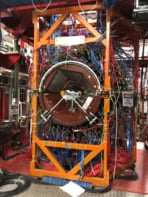Ultrasound devices have revolutionised several forms of medical surgery and are well known by parents for providing the first picture of an unborn child. However, the technology behind ultrasound has not advanced much since the 1970s. Now Hiroyuki Shinoda and colleagues from Tokyo University of Agriculture and Engineering have discovered a new technique for generating high-intensity ultrasound that is based on heat conduction in porous silicon (Nature 400 853).
Currently most ultrasound devices convert an electrical signal directly into mechanical vibrations through the piezoelectric effect. But these devices only operate over a narrow frequency range and have limited output. The idea of using heat to generate sound has been around for over 80 years, but until recently the thermal conduction of porous silicon was considered too low for this approach to work.
This new device does not produce mechanical vibrations and is therefore more reliable than standard piezoelectric transducers. Moreover, its wide frequency range makes it suitable for recording images through many different types of material. And as the base of the device is made from crystalline silicon, it should be straightforward to integrate it with conventional electronic circuitry.



